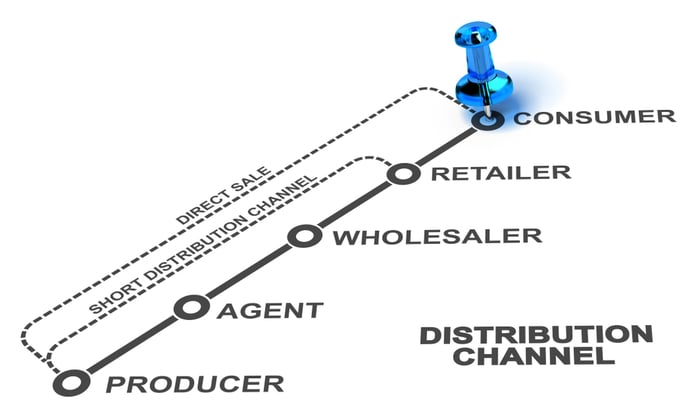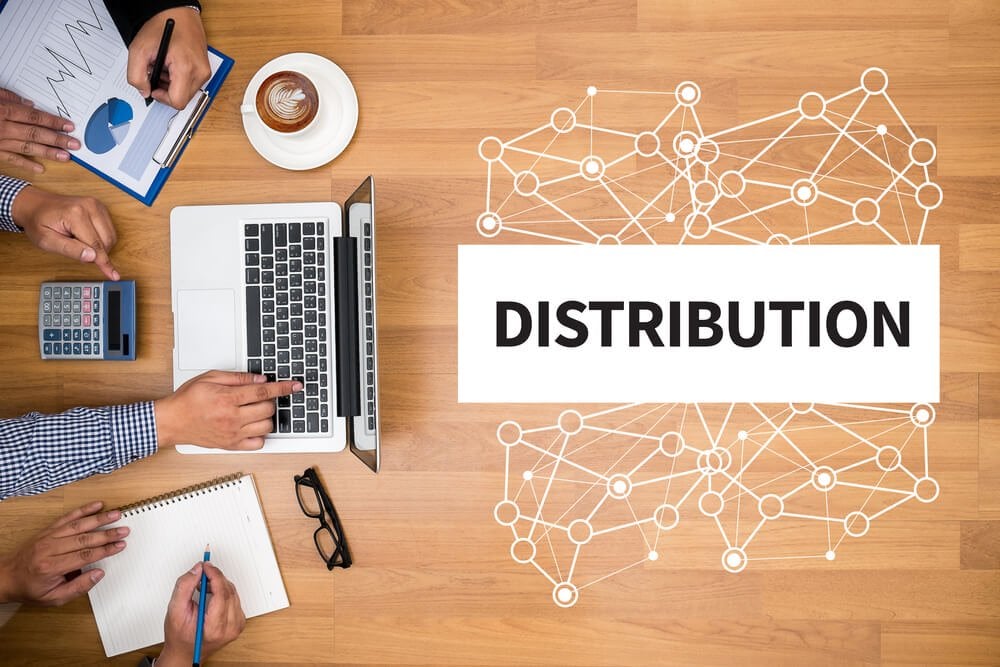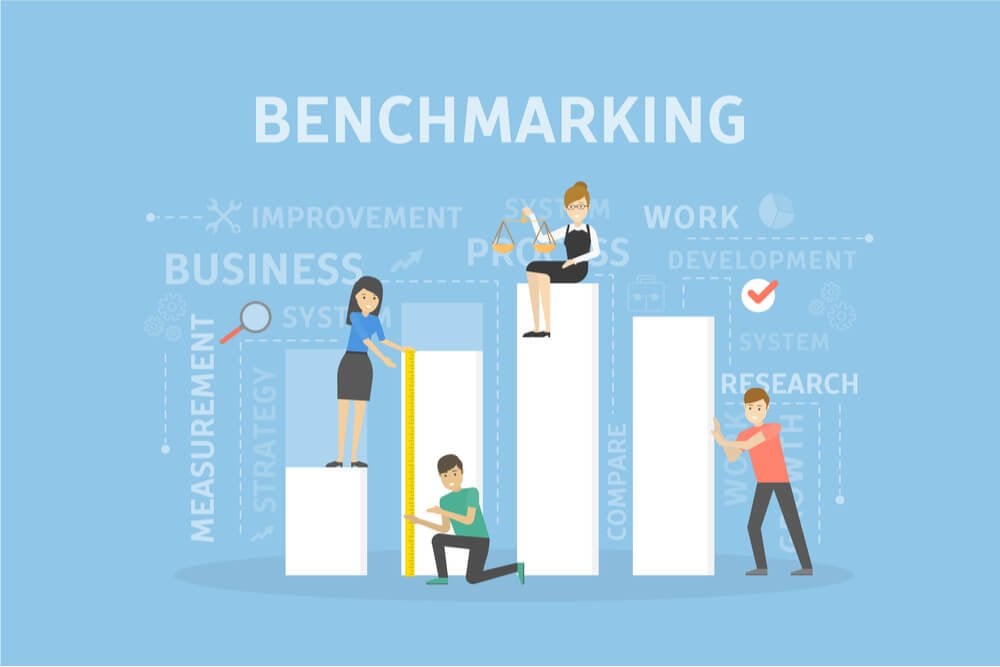
Have you defined the distribution channels that will be used by your company?
If not, it’s time.
In short, distribution channels determine the path goods will take from the manufacturer to the final consumer.
Thus, they have direct impact over sales.
There are many types, formats, and levels of distribution channels.
The first step is to understand each of them.
To help you with this task, this page will go over the main things you need to know about distribution channels:
- what distribution channels are
- the three types of distribution channels
- three distribution methods
- distribution levels
- the main intermediaries
- how to define them
What Are Distribution Channels?

Distribution channels are the path products take from their initial manufacturing stage to selling them to consumers. The main goal of these channels is to make goods available to final consumers in sales outlets as soon as possible.
Distribution channels directly impact a company’s sales, so you want to make them as efficient as possible.
The Three Types of Distribution Channels
There are three ways to make sure a product gets to the final consumer.
1. Direct Channels
With direct channels, the company is fully responsible for delivering products to consumers. Goods do not go through intermediaries before reaching their final destination. This model gives manufacturers total control over the distribution channel.
This is the case with people who do catalog sales, for example.
Since the manufacturer alone is responsible for delivering products, this channel generally makes it impossible to have a high number of customers.
At the same time, it’s possible to offer lower prices, since the company does not have to pay commission to intermediaries.
2. Indirect Channels
With indirect channels products are delivered by intermediaries, not by the sellers.
Who are these intermediaries? They could be wholesalers, retailers, distributors, or brokers, for example.
In this case, manufacturers do not have total control over distribution channels.
The benefit is that this makes it possible to sell larger volumes and sell to a range of customers. However, products have higher prices due to the commissions paid to intermediaries.
3. Hybrid Channels
Hybrid channels are a mix of direct and indirect channels.
In this model, the manufacturer has a partnership with intermediaries, but it still takes control when it comes to contact with customers.
One example is brands that promote products online but don’t deliver them directly to customers.
Instead, they nominate authorized distributors.
Three Methods for Distribution Channels
There are three different delivery methods for distribution.
Basically, they concern who will be allowed to sell your products.
1. Exclusive Distribution
With exclusive distribution, intermediaries take the company’s products to specific sales outlets.
This is usually done by a sales representative.
This means that only exclusive retail outlets will be able to sell the items to consumers.
Depending on the quality of the product, this is a great strategy not only for manufacturers but also for the retail outlets or chain stores selected.
2. Selective Distribution
With selective distribution, the company allows sales to a specific group of intermediaries who are responsible for selling items to final customers.
An important factor in how succesful this strategy will be is the reputation of the intermediaries since they have a direct impact over the company’s performance.
In this case, the intermediary becomes the real consultant for consumers, answering questions and recommending appropriate products for their needs.
3. Intensive Distribution
In intensive distribution, the manufacturer tries to place their product in as many sales outlets as possible.
The manufacturers themselves, sales teams, and commercial representatives are all involved in this method. They are responsible for distributing products to sales outlets.
This distribution method is generally used by manufacturers of low-cost products with a high frequency of consumption.
Distribution Channel Levels
Besides the types and methods of distribution channels, they may also operate on different levels.
Their levels represent the distance between the manufacturer and the final consumer.
Level 0 Distribution Channel
In this level, there is a close and direct relationship between the manufacturer and the client.
For the company, the costs of the relationship with the consumer are higher.
Level 1 Distribution Channel
In level 1, the manufacturer sells the products to the distributor, who might sell it to consumers via retailers or wholesalers.
The distributor keeps some of the rights to the product, but not all.
The distributor is also responsible for the costs of sales and transportation to sales outlets.
Level 2 Distribution Channel
Level 2 is similar to level 1.
The difference is that in this case, the distributor delivers products only to retailers, who sell them to consumers.
Level 3 Distribution Channel
Level 3 channels are a traditional distribution model.
The product’s journey from the manufacturer involves distributor, retailer, and customer.
The costs relative to sales and marketing are divided between the parties.
The advantage of this model is that it’s possible to reach a larger number of consumers.
On the other hand, products have a higher price because of the operational costs of all the parties involved.
The Nine Main Intermediaries in Distribution Channels
After finding out more about operation details, it’s time to see who are the main intermediaries who take products to consumers.
1. Retailers
Retailers are intermediaries used frequently by companies.
Examples include supermarkets, pharmacies, restaurants, and bars. Each of these types of businesses has full sales rights.
Generally, product prices are higher in retailers.
2. Wholesalers
Wholesalers are intermediaries that buy and resell products to retailers. Wholesalers sell to those who are going to put products in their own stores.
These intermediaries generally don’t sell small quantities to final consumers, though there are exceptions, like supermarkets that sell in the wholesale model.
Prices are lower because sales involve large quantities.
3. Distributors
Distributors sell, store, and offer technical support to retailers and wholesalers. Their operations are focused on specific regions.
4. Agents
Agents are legal entities hired to sell a company’s goods to final consumers and are paid a commission for their sales.
In this case, the relationships between intermediaries and companies are for the long term.
5. Brokers
Brokers are also hired to sell and receive a commission.
The difference between agents and brokers is that brokers have short term relationships with the company.
That’s the case with real estate agents and insurance brokers, for example.
6. The Internet
To those who sell tech and software, the internet itself works as the intermediary of the distribution channel.
The consumer only has to download the material to have access to it.
E-commerce companies also use the internet as a distribution intermediary.
7. Sales Teams
A company can also have its own sales team who are responsible for selling goods or services.
There is also the possibility of creating more than one team to sell to various segments and audiences if the company has a wide range of products.
8. Resellers
Resellers are companies or people who buy from manufacturers or retailers to later sell to consumers in retail.
9. Catalog
Catalog sales, as the name indicates, is when a salesperson is connected to a company and sells its products using a magazine. Salespeople in this model also usually earn a commission for their sales.
This type of sales is common in the beauty segment, with brands like Avon and the Brazilian Natura.
Reverse Distribution Channel
Now you know the types and methods available for products to reach customers. But what happens when consumers need to return items to manufacturers?
Consumers need to rely on reverse distribution if they receive defective products or need to return clothes or shoes they bought online that don’t fit.
In this case, the consumer is responsible for returning the items and needs to find information from the manufacturer about how to do this. Usually, consumers find information about returns on the site for the product.
How to Define Distribution Channels for Your Product

Now you know the different types of distribution channels and intermediaries. But all this is of no use if you don’t know how to select the appropriate channel for your company.
Next up are seven essential tips to help you make this decision.
1. Benchmarking
First, you must look at your competitors to find the best practices they adopt.
This kind of mapping is known as benchmarking.
The idea is to figure out how your competitors are distributing their products and adopt a similar model.
2. Project Review
So you have mapped out best practices in the market and identified solutions that could work for your business.
Great.
The next step is to review the project/channel you created.
Check if there are errors and how processes may be optimized and adapt the project to the needs and characteristics of the type of sales you make.
3. Costs and Benefits
When we talk about distribution channels, one important factor is the cost associated with them.
Always look for the best cost-benefit ratio.
To do this, it is not enough to have a vague idea of the costs. You must record all costs and analyze if the benefits of the channel you selected are worth it.
4. Company’s Daily Routine
Another relevant factor is the business’ routine.
What are the projects, processes, and activities in your business?
The distribution channel must be aligned with all these details.
Otherwise, you might have logistics problems that result in product delays that damage your relationship with customers.
5. Market Potential
Before selecting a channel, you should also consider the market potential of intermediaries.
After all, unless you choose to use direct channels, they will also be responsible for sales results.
Analyze intermediaries’ market participation, reputation, and performance to only then try to select the most appropriate option.
6. Logistics
Consider logistical questions like:
- How will products be transported?
- Is there security for when the products are in transit and/or where they are stored?
- Where will goods be stored?
- What will be the delivery time, on average?
Considering all stages of logistics is crucial to avoid problems taking goods to sales outlets.
7. Location
Finally, consider the location of intermediaries, whether they are resellers, retailers, wholesalers, or distributors.
After all, your product must be sold in the region where your target audience is, especially if you supply a specific niche of the market.
Managing Distribution Channels
How should you manage your company’s distribution channels? This is usually the responsibility of marketing departments.
To do it, it’s essential to monitor key performance indicators (KPIs).
Carry out regular assessments of reports with metrics and indicators related to distribution processes.
Monitor sales indicators, for example, analyzing the performance of each channel the company uses.
Also, carry out satisfaction surveys with consumers, especially when customers are dissatisfied with the selection and availability of goods or when sales volume is below expectations.
Examples of Distribution Channels

Before concluding this reading, how about we get to know two examples from great companies?
Coca-Cola’s Distribution Channels
The largest soft drink manufacturer in the world uses different sales channels with franchisers, distributors, and retailers.
For example, soft drinks get to different retailers thanks to distributors.
This includes bars, restaurants, and supermarkets, who sell directly to final consumers.
Natura’s Distribution Channels
Cosmetics brand Natura basically uses catalog distribution, though today there are sales outlets as well.
The company has a network of consultants that sell to consumers using magazines showing the products.
Distribution Channels Conclusion
Are you ready to define and manage distribution channels for your company?
Follow the steps I mentioned in this article, from benchmarking to sales outlet analysis.
Consider the cost-benefit ratio of each channel.
And regardless of your choice, always monitor indicators and metrics.
This analysis makes it possible to check the efficiency of the distribution channel so you can optimize it constantly.
Did you like the tips in this article?
Leave a comment with your opinion or any questions you may have.
from Blog – Neil Patel https://ift.tt/3pvoKBL

No comments:
Post a Comment